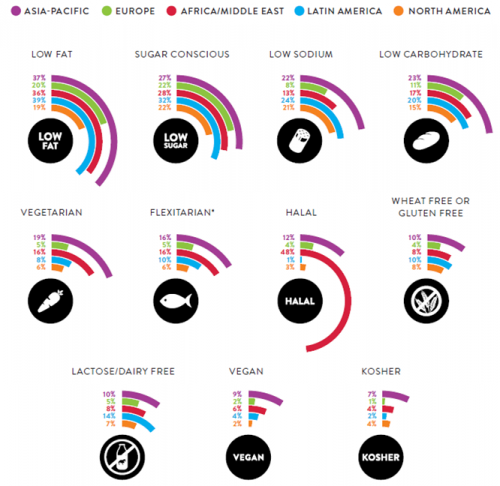Global food trends
Consumers increasingly interested in healthy eating.
According to the 2015-2020 Dietary Guidelines for Americans, nearly 50 percent of American adults have one or more diet-related, chronic diseases that could be prevented by healthy eating and exercise. The U.S. Center for Disease Control and Prevention suggests that healthy eating is an important aspect of an overall healthy lifestyle (CDC, 2016). U.S. policy makers, government agencies, schools, businesses and consumers have expressed increased interest in healthy eating (Nielsen, 2016). This trend is pervasive across the globe. Many consumers are making the connection between improved nutrition and overall health.
The Nielsen Global Health and Ingredient-Sentiment Survey offers a global perspective on consumer sentiment of available foods, as well as self-reported dietary restrictions (Nielsen, 2016). Seventy percent of global respondents suggest they actively make dietary choices to prevent disease and health conditions. Sixty-four percent of global respondents suggest that they “follow a diet that limits or prohibits consumption of some foods or ingredients” (Nielsen, 2016). While food and ingredient limitations vary by global region, one commonality across regions is the desire of respondents to avoid foods with artificial ingredients (62 percent), preservatives (62 percent) and colors (61 percent). Interestingly, U.S. sales volume of products labeled as “hormone- or antibiotic free” and “made without artificial colors or flavors” increased in 2016 as compared to 2015. This indicates that consumers could be altering spending habits based upon sentiment. Further support for “simple ingredients” is evidenced by the 2015 Food Business News Trend of the Year: Clean Label. Consumer demand for increased transparency and fewer artificial ingredients may well represent an increasing market opportunity for food manufacturing businesses. If you have an idea for a food or agricultural related business, the Michigan State University Product Center offers a range of services to help you move your idea forward. For more information on food and health in Michigan, please visit the Michigan State University Extension Food and Health page where you can sign up for a weekly newsletter to keep abreast of the latest information.
Percent of respondents that suggest they follow a special diet that limits or restricts specified foods or ingredients. | Photo from Nielsen



 Print
Print Email
Email



